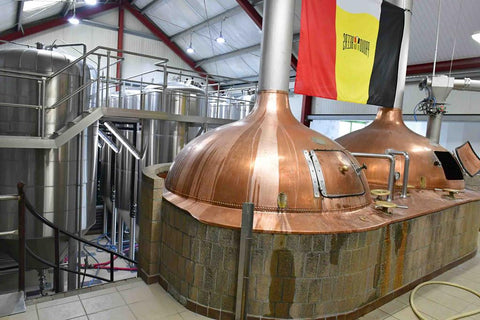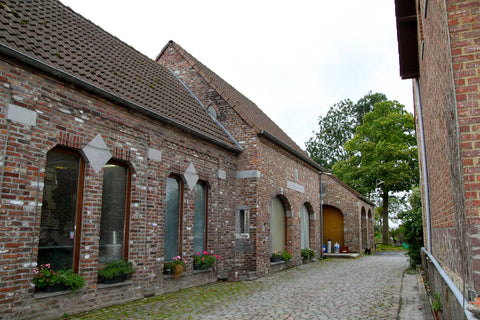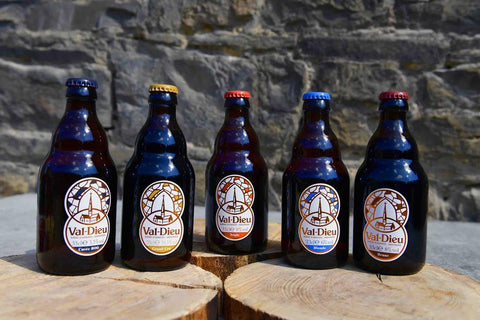- No products in the cart.
Brasserie St-Feuillien

The Beginning - The Friart family have been brewing beer here in Le Roeulx, close to Bergen (Mons) in Hainaut, since 1873, with their best-known brew being the eponymous Saint-Feuillien. Where to look for the origin of this name? Well, as you might perhaps guess, there's a link to a saint – and to a long-time brewing abbey.
It was in the 7th century that the Irish monk Feuillien arrived on the continent to preach the gospel. He stayed in nearby Fosses-la-Villes, east of Charleroi, which is where his relics are now kept. In 655, while travelling through the Le Roeulx area, he was waylaid by robbers, tortured and decapitated.
His followers then erected a chapel on the spot where he suffered such a gruesome martyr’s death. In 1125, the Premonstratensian abbey of St-Feuillien was founded in the same place. Its monks were hard-working fellows and abbey beer, for sustenance and quenching of thirst, was brewed here for some centuries.
1796, the time of the French Revolution, saw the destruction of the abbey, which was then located in the grounds of the current (private) Le Roeulx castle. The Friart family see themselves as continuing that brewing tradition. Stéphanie Friart and her husband started brewing in Le Roeulx, albeit in a different location to the current brewery premises. In 1920 brewing activity moved to the buildings, dating back to 1893, that are still in use today. The second generation took over in 1910 with Benoît Friart, succeeded in 1950 by his son, also called Benoît.
It was he who developed the recipe for the much-praised, and rather popular, Saint-Feuillien Blonde. Since 1980, Saint-Feuillien has been in the hands of the fourth generation: Benoît Friart and his sister Dominique.
During the 1980s production had to be outsourced for a number of years as renovation works were urgently needed. The beautifully preserved 19th-century brewery was still being used right up until 2013, when it was replaced by a brand new brewing hall. Brewmaster Alexis Briol has now given the brewery a second lease of life.
Saint-Feuillien is predominantly known these days for the strikingly spicy character of its popular Saint-Feuillien beers. The Saint-Feuillien Blonde (1952) is also considered the beer that represents and characterises the city of Bergen (Mons). This tripel is in fact strongly promoted by a local confrérie association.
Another stalwart of Saint-Feuillien, the Grisette, also flows from the local tradition. It is a rather light, hoppy, top-fermented beer that makes for an excellent thirst quencher – well-hopped and slightly heavier (5.5% ABV) than was usual for the time it was introduced. The range also includes a saison, a beer-style typical of the Hainaut region.

To commemorate the forthcoming celebrations of ‘2015, Bergen, European Capital of Culture’, St-Feuillien has recently launched the Car d’Or – another thirst quencher, with a nod to Bergen's folklore.
It's named after the city's golden processional carriage – the Car d'Or – which is the centrepiece of the Doudou festival, held in Bergen in May or June. A cheese has also been developed in tandem with this beer. In the meantime the brewery is looking far beyond the Belgian border for inspirational collaboration.
Every year since 2010, a beer has been developed in co-operation with an American brewer. This ‘bière de l’amitié’ or ‘friendship beer’ can be said to be ‘the best of two (brewing) worlds’: the fruit of the marriage between European and American varieties of hops and malt, using the Saint-Feuillien house yeast and flavoured with a subtle dose of herbs.
The Brewing

Saint-Feuillien produces top-fermented beers that re-ferment in the bottle in the traditional way. To achieve this, the brewer uses the infusion method, where warm water is added to the malt mixture in various stages until the desired temperature of 75°C is reached. This is required to convert starch into soluble sugar.
The filtered wort is then boiled together with the hops, over a period of one and a half hours. The beer will next spend six weeks in the cold chamber (cooled to 0°C). During this time it clarifies completely and develops its taste.
Yeast and sugar is then added for the in-bottle re-fermentation; the beer is bottled and spends three weeks in the warm chamber (25°C) to re-ferment and become saturated. The Saint-Feuillien brewery uses quite hard well water (from 65m underground) which has had the iron content removed. The house yeast, which is propagated on-site, lends it a fruity character and (critically) it remains active at the low temperatures of the cold chamber. These are beers that are given plenty of time to fully complete fermentation.
In contrast to the Saint-Feuillien, however, the Grisette ferments and matures in separate basins, designed especially for the purpose. The Saint-Feuillien house yeast adapts perfectly to basins of various shapes.
The Brewers

The current brewer, Alexis Briol, has developed the recipes for all of the beers in the range, with the exception of the Saint-Feuillien Blonde. That owes its existence to the work of Benoît Friart (from the 3rd generation of this brewing family). The recipe has, however, been altered slightly throughout the years.
This has made the Saint-Feuillien Blonde into a hoppier, more aromatic beer, that tastes somewhat fuller in the mouth. It is brewed using only the sugar from barley malt, and a dose of natural Styrian Golding and Saaz hops and aromatics.
As far as its own beers are concerned, Saint-Feuillien is heavily focused on the ‘stayers’ in its range – such as the classic, unfiltered Saison or the light, delicate, zesty Grisette. Saint-Feuillien also strives to ensure their predominantly blonde beers are full of character, stressing those aspects that make their range distinctive.
And the aromatic character of these beers is quite striking. On the other hand, the ‘collaboration brews’ with the American brewers are more varied.
The joint effort could result in a typically Belgian beer one year, or an American beer, an IPA for example, the next. The thinking at St Feuillien is that this allows the brewer to get to know American hops, and techniques such as late hopping or dry hopping. These experimental brews, marketed in limited editions, represent a continuous search for balance between aroma and bitterness.
The Beers
The Visit

The visit begins in the original brewery (dating back to 1893), which really is heaven for lovers of traditional brewing technology. You will gain a real insight into the brewing process, from start to finish in a genuinely authentic and historic environment.
The old brewing hall has the original mixing vessel on display, which was used for the malt mixture until 2013. You can also see the antique threshing mill used to grind the malt, which was stored on the top floor, before being transporting to the tun.
There then follows a tour of the yeast hall, with its arsenal of storage tanks. This is where you swap the past for the present, as you move into the working brewery. The tour takes a close look at the bottling plant – used only for large bottles – and the production line where the barrels are filled. And naturally your tour wouldn't be complete without a tasting of two beers of your choice at the bar.
A guided tour takes around an hour and a half. The brewery offers such visits every day, for groups of a minimum of 10. But at 2pm every Saturday you can join a group on an individual basis, without prior reservation.
The Location

It's well worth taking advantage of your visit to the brewery to take in the sights of this part of Hainaut. First and foremost, there is the splendid medieval Saint-Jacques hospital, a stop on the pilgrimage route to Santiago de Compostela, where travellers were received and looked after over the centuries. It is also famed for its beautiful rose garden.
Le Roeulx market square has had the status of conservation area since 1980. There are a number of handsome 18th-century facades here, as well as an elegant town park.
Close by are the famous hydraulic boat lifts on the Centrumkanaal (Canal du Centre), now a designated UNESCO World Heritage Site, and the 117m high boat lift of Strépy-Thieu, a major feat of engineering. And if you want to stay with the river navigation theme, then a visit to the Inclined Plane at Ronquières – an imposing boat lift on the Brussels-Charleroi canal – is definitely in order. Also close-to is Mariemont, which offers up the beauty of the Royal Museum, with its unique artefacts from China, Japan, Egypt, Greece and the Roman Empire.
On display is a collection on the history of Hainaut, the home region of Le Roeulx. It spans over twenty centuries and includes beautiful porcelain from Doornik (Tournai).
The nearby historic city of Nijvel (Nivelles) is famed for its majestic Church of Sainte Gertrude (1046). It is built in a Romanesque style, with its crypt and cloisters reminding you of the former abbey: a must for lovers of medieval architecture.
The church’s treasures, include the figures on display in a medieval relic shrine, and the procession cart, 500 years old, which is still used for Nijvel's annual procession, the Ommegang. Bergen (Mons) – the European Capital of Culture for 2015 – is 20 km away from Le Roeulx. An artistic city with regular exhibitions, it has turned Van Gogh's town-house (he spent some time in the city) into a display of the man, his works and his life.

The market square is particularly well-endowed, with its splendid town hall, contemporary art museum BAM, the Church of Sainte-Waudru and the Mundaneum. A walk around the well-preserved city walls is another activity sure to reward your efforts.
Not far from the city you can pay a visit to MAC’S museum of modern art at Le Grand Hornu – a former mining site – and the PASS science museum, also found in a converted mine.
The nearby small town of Binche has achieved worldwide fame through its carnival, with the costumed, clog-wearing, orange-throwing 'Gilles'. It's an experience like no other, but if you're not there at festival time, the carnival museum is open all the year around. A real contrast is the Bois du Luc (1838), a UNESCO World Heritage Site, that brings an old Hainaut mining village back to life. Across a site of some two hectares, you can explore an entire miner's community, with its school, hospital, cottages, a church and workshops.
Getting There & Around
Le Roeulx lies to the south west of Brussels, centrally located between Nijvel, Zinnik, Bergen and La Louvière. By car, the trip from Brussels to Le Roeulx takes about an hour. Take the E19 in the direction of Paris, leave at exit 21, which is signposted for Le Roeulx, Zinnik, Binche.
The nearest railway station with the best services is Zinnik, though this is some 10 kilometres away. Bus number 134, however, will get you to your destination in Le Roelux. Take note of the fact that not too many buses are run at the weekend, however.
Gastronomy, Food & More Beer
.jpg?1372534720)
The Saint-Feuillien brewery prides itself on a culinary beer tradition that goes back well before the phrase 'beer cuisine' became so fashionable. As early as 1960 the dish ‘Sweetbreads of Veal with Saint-Feuillien’ was awarded the Prix Prosper Montagné. You're still certain to find this particular recipe on the menu of the Devos restaurant in Bergen.
The Saint-Feuillien Blonde also gives added flavour to fish dishes, especially, including escavèche – a preparation of eel or trout pickled in vinegar, a dish that is typical of the Chimay region. The Saint-Feuillien beers also enhance veal or chicken recipes, whether it's on or next to the plate.
For an in-between course or dessert, the choice is easily made. Opt for the Grisette Fruits des Bois, in a sorbet of raspberry, blueberry and blackberry, with this refreshing fruit beer on the side. When it comes to cheese, we recommend the unpasteurised, semi-hard Saint-Feuillien cheese made by Ferme du Bailli in Soignies. This can be enjoyed on its own, or as part of a bacon quiche. The ideal partner for the cheese? Why a Saint-Feuillien Blonde, naturally.
More Info
Tourist information for Le Roeulx:
VVV Le Roeulx
Grand Place 1
B-7070 Le Roeulx
Tel: +32 (0) 64 31 07 60
Website: www.leroeulxtourisme.be
Tourist information for Henegowen/ Hainaut region:
Toerisme Henegouwen
Rue des Clercs 31
B-7000 Bergen
Tel: +32(0)65 36 04 64
Email: federation.tourisme@hainaut.be
Website: www.hainauttourisme.be
Contact

Brasserie de Saint-Feuillien
Rue d’Houdeng 20
B-7070 Le Roeulx
Rue d’Houdeng 20
B-7070 Le Roeulx








